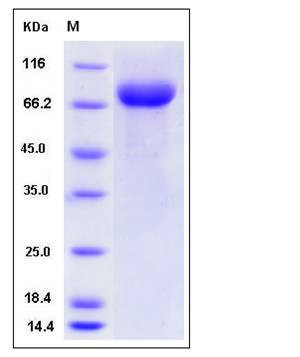Mouse LILRB3 / LIR3 / ILT5 / CD85a Protein (His Tag)
Gp91,Pirb
- 100ug (NPP3392) Please inquiry
| Catalog Number | P50760-M08H |
|---|---|
| Organism Species | Mouse |
| Host | Human Cells |
| Synonyms | Gp91,Pirb |
| Molecular Weight | The secreted recombinant mouse LILRB3 comprises 627 amino acids and has a calculated molecular mass of 70 kDa. The apparent molecular mass of rmLILRB3 is approximately 73 kDa in SDS-PAGE under reducing conditions. |
| predicted N | Ser 25 |
| SDS-PAGE |  |
| Purity | > 95 % as determined by SDS-PAGE |
| Protein Construction | A DNA sequence encoding the extracellular domain of mouse LILRB3 (AAC53219.1) (Met 1-Tyr 640), was fused with a C-terminal polyhistidine tag. |
| Bio-activity | |
| Research Area | Immunology |Adaptive Immunity |Major Histocompatibility Complex (MHC) |MHC Class I |
| Formulation | Lyophilized from sterile PBS, pH 7.4 1. Normally 5 % - 8 % trehalose and mannitol are added as protectants before lyophilization. Specific concentrations are included in the hardcopy of COA. |
| Background | Leukocyte immunoglobulin-like receptor subfamily B member 3, also known as Leukocyte immunoglobulin-like receptor 3, Immunoglobulin-like transcript 5, Monocyte inhibitory receptor HL9, CD85 antigen-like family member A, CD85a and LILRB3, is a single-pass type I membrane protein which belongs to the leukocyte receptor cluster (LRC) present on 19q13.4. LILRB3 / CD85a contains four Ig-like C2-type (immunoglobulin-like) domains. LILRB3 / CD85a contains three copies of a cytoplasmic motif that is referred to as the immunoreceptor tyrosine-based inhibitor motif (ITIM). This motif is involved in modulation of cellular responses. The phosphorylated ITIM motif can bind the SH2 domain of several SH2-containing phosphatases. LILRB3 / CD85a is expressed on immune cells where it binds to MHC class I molecules on antigen-presenting cells and transduces a negative signal that inhibits stimulation of an immune response. It is thought to control inflammatory responses and cytotoxicity to help focus the immune response and limit autoreactivity. Multiple transcript variants encoding different isoforms have been found. |
| Reference |
